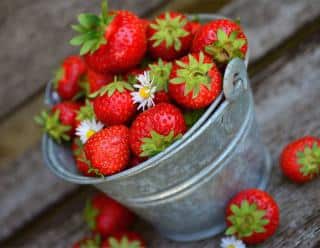

Small and tasty, nutritious strawberry only weighs a couple grams, not much more than when it was first discovered in forest underbrush many years ago.
It is of course very much appreciated in desserts and jam, but why not pair it with salty main courses?
Strawberry is one the best fruits to replenish your energy thanks to its record vitamin C content.
Early March is when the first spring strawberries appear in the warmth of our greenhouses. Fleshy and soft, strawberry helps recharge your batteries after winter thanks to its very interesting properties.
Low calorie and antioxidant strawberry can be eaten without restraint!

In the botanical sense, strawberries aren’t fruits. What botanists consider fruits are mature ovaries. But actually, strawberries are differently structures: the tip of the peduncle swells and ripens, and the fruits are the tiny “seeds” that appear on its surface.
Decoction of crushed and chopped leaves and roots – more or less 1 oz (30 g) for 1 quart (1 liter) water. Boil for a few minutes and drink abundantly during the day. Against urinary disorders and diarrhea.
Strawberry leaf herbal tea – 0.7 to 1.4 oz (20 to 40 g) for 1 quart (1 liter) water. Collect the leaves in spring and dry them. Diuretic, excellent to replace tea.
Strawberry face mask – simply apply mashed strawberries on a clean face with no make-up and keep in place with gauze. Let it work for 10-15 minutes and rinse off.
Strawberry plants require full sun. Sun is what gives the strawberries their fragrance and ensures a high sugar content. Strawberry plants are hardy and can cope with freezing in most temperate climate areas.
As for the soil, best is when it is rich and well drained, not too chalky. Regular weeding is a good idea.
Raw strawberry is delicious, but you can also sprinkle sugar on it. It is a delicacy in pastries, ice cream, syrups, compotes, and jams but strawberry doesn’t hold well to long cooking.
The taste of the strawberry is at its fullest when it is served slightly warm, quickly run in a pan or on the grill.
–>
Savory ideas with strawberry
Strawberry cheesecake, old-style strawberry pie, strawberry pastries, strawberry jam… Feeling hungry yet?
30 kcal / 3.5 oz (100 g). Strawberry is about 90% water and only 5% sugar. The fruit has high levels of vitamin C, 65 mg / 3.5 oz (100 g), more than orange. Strawberry also contains vitamin B9 as well as fibers and various trace elements such as potassium, 160 mg / 3.5 oz (100 g), bromine, iron, iodine, calcium, magnesium, selenium and sulfur.
Strawberry slows cell ageing thanks to the folic acid (vitamin B9) that is present.
Blandine Merlin